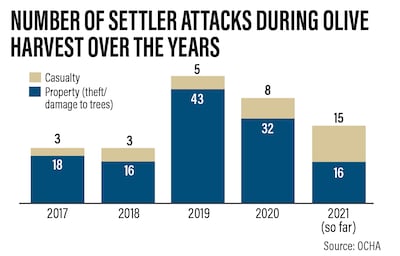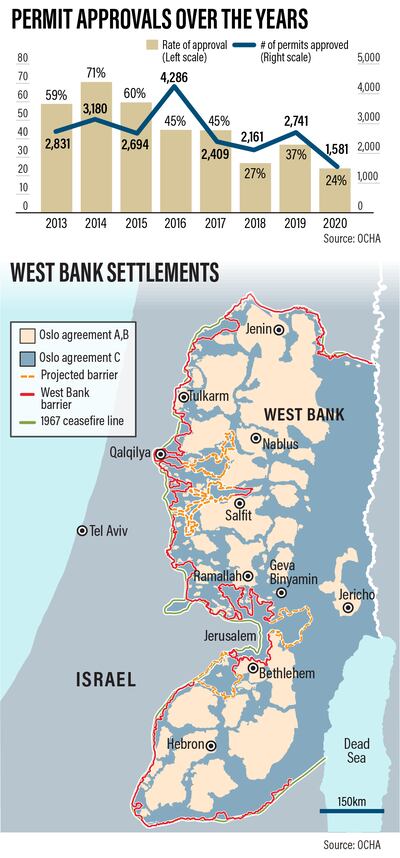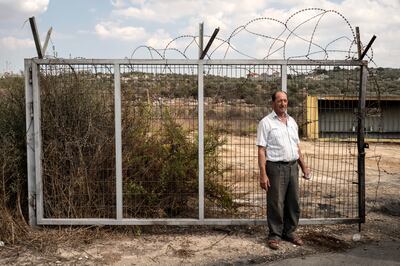In an olive grove south of Nablus, in the West Bank, Moath Omran recalled the moment his village of Burin was attacked by Israeli settlers.
“It was a big clash,” he said of the incident last month, when four Palestinians were wounded by stones thrown by settlers. Trees and houses were also damaged, the UN office for humanitarian affairs (OCHA) reported.
“Every year, when they see people start harvesting the olives they start throwing rocks and also setting fire to the land,” said 30-year-old Mr Omran. Around him, people plucked olives from the trees.
“The roots of olive oil go back to our ancestors,” he said, describing how the crop is pressed into oil or used in cosmetics. “This land can grow olives very well, so we take advantage.”
But such a tradition is under threat. So far about 2,200 trees have been damaged during this year's harvest, according to OCHA's latest data.
With the harvest still continuing, the figure has already surpassed the more than 1,700 trees that were vandalised during last year’s season.

Palestinian farmers say that Israeli soldiers, who exercise military control in the West Bank, fail to intervene and protect Palestinians or their trees from such attacks.
The military said that is “a generalisation and incorrect".
“As a rule, IDF [Israeli] troops act to prevent escalation and reduce conflict when they detect acts of violence in the area,” the military told The National.
Last week, the International Committee of the Red Cross said its employees were attacked with pepper spray by Israeli settlers near Burin, while visiting the area alongside Palestinian farmers and Israeli military officials. The team was taken to an Israeli base for treatment, the ICRC said.
Environmental effect of olive tree destruction

Alongside such physical violence, destruction of the native olive tree has serious consequences for the land itself.
“In addition to the significant economic and social impact on the livelihoods and food security of the farmers, burning of olive trees has three main types of adverse effects on the environment,” said Ciro Fiorillo, head of the West Bank and Gaza office for the UN’s Food and Agriculture Organisation (FAO).
The result is greater soil erosion and desertification, the direct emission of the harmful gas CO2 into the atmosphere, and the loss of trees storing CO2 in their biomass.
“On average, each medium-sized olive tree removes around 8.35 kilograms of CO2 from the atmosphere annually. Thus, destroying the trees will also destroy this capacity,” Mr Fiorillo told The National.
There are repeated efforts to replant destroyed trees, including by Israeli activists, who earlier this year brought 200 trees to plant in Burin.
“A week later we came [back again] and a lot of the trees were uprooted – the new trees – so we replanted them,” said Rabbi Nava Hefetz.

A member of the Israeli organisation Rabbis for Human Rights, the 66-year-old has for years been harvesting olives alongside Israeli and foreign volunteers. Activists have also been attacked by settlers, including an elderly rabbi whose arm was broken in 2019.
“We are going to places where there is a threat on the Palestinian farmers,” she said, standing between olive trees in the Burin area.
Lack of access makes harvest even harder
While many farmers are at risk of physical violence during the harvest, others have trouble even reaching their land.
In the early 2000s, Israel began constructing a barrier snaking through the West Bank that it said was necessary for security reasons.
Some 85 per cent of the barrier has been built inside the Palestinian territory, according to the UN, rather than constructed on the internationally-recognised border with Israel.

As a result, Palestinians must apply for an Israeli permit to access their land behind the barrier.
In the village of Qaffin, for example, permit-holders are just granted a few minutes three times a day to reach their land.
“It’s not enough to serve the land,” said Taysir Harishi, a former mayor of the village.
“Three to four times per year, fires take place … you cannot get the fire brigade, you cannot even enter”, he said, standing beside the gate with scorched land behind him.

Some 73 per cent of farmers’ permit applications were refused last year, up from 29 per cent in 2014, according to figures obtained by Israeli rights NGO HaMoked.
Usually farmers in Qaffin can cross into the so-called Seam Zone three days a week, though they can enter daily during the olive harvest. Permits are restricted to landowners, who must request special permission to have others help them during the season.
“Me, my sons, my daughters, my wife, we all worked on the land” before the barrier, said farmer Ibrahim Amar. The family home in Qaffin lies just 300 metres from his crops.

“From my house to the gate, I have to walk around a kilometre and a half,” said Mr Amar, 64, standing beside the barrier. “From here to the land, around a kilometre and a half [further].”
Mr Amar said he used to grow other crops such as watermelon and corn, but his limited access means he can now only rely on hardy olive and almond trees. This loss has led him to supplement his income with taxi driving.
Despite olive trees growing throughout the West Bank, making a living from the crop is challenging.
According to figures issued by the UN, about 80,000 Palestinian families earn their income from growing olives in plantations. However, just 3 per cent of Palestinian olive oil is exported to “premium markets” beyond the Middle East, a 2018 World Bank report said.

For consumers the price is around 35 to 40 per cent higher than Turkish olive oil, due to production costs. These include everything from the relatively high price of labour to restrictions on movement, including Israeli checkpoints, said the World Bank.
Farmers in Gaza are under greater restrictions than those in the West Bank. Israel has led a blockade of the Palestinian enclave since 2007, severely limiting the entry and exit of goods and people.
Mohamed Naser Ouda, the manager of an olive press in Gaza, said farmers were able to export olive oil last year but the current harvest is proving less promising.

“This surplus was exported to Saudi Arabia and the United Arab Emirates,” he said. “But this year, due to low production, there is no commercial export.”
The harvest can nonetheless provide an opportunity for some in Gaza, where the World Bank estimates unemployment stands at about 50 per cent.
Talaat Abu Jiyab, a Gazan farmer, said he was inundated with calls from potential pickers but could take on no more than 50.
“This is an opportunity for an unemployed worker who waits the whole year for this season, to work for a month harvesting olives at a rate of 30 shekels ($9.4) a day,” said the 55-year-old.
A national symbol of attachment to land
Going beyond economics, Mr Abu Jiyab said olives remain an important symbol across Palestine.
“Palestinians cherish this tree,” he said, which has grown for hundreds of years.
“Whether we are in the West Bank, the Gaza Strip, the border areas or far from the border areas, we consider this tree like one of our children.”














